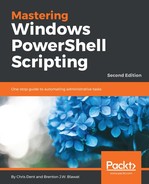If the Confirm parameter is not set, whether or not a prompt is shown is determined by PowerShell. The value of the ConfirmPreference variable is compared with the stated impact of a command.
By default, the value of ConfirmPreference is High, as shown in the following code:
PS> $ConfirmPreference
High
By default, commands have a medium impact.
Finding ConfirmImpact:
In scripts and functions, the ConfirmImpact setting is part of the CmdletBinding attribute:
[CmdletBinding(ConfirmImpact = 'High')]
If CmdletBinding or ConfirmImpact are not present, the impact is medium.
The impact of a function or cmdlet may be viewed using the ConfirmImpact property of a command's metadata:
New-Object System.Management.Automation.CommandMetadata(Get-Command Remove-Item)
In scripts and functions, the ConfirmImpact setting is part of the CmdletBinding attribute:
[CmdletBinding(ConfirmImpact = 'High')]
If CmdletBinding or ConfirmImpact are not present, the impact is medium.
The impact of a function or cmdlet may be viewed using the ConfirmImpact property of a command's metadata:
New-Object System.Management.Automation.CommandMetadata(Get-Command Remove-Item)
ConfirmPreference has four possible values:
- High : Prompts when command impact is High (default)
- Medium : Prompts when command impact is Medium or High
- Low : Prompts when command impact is Low, Medium, or High
- None : Never prompts
A new value may be set by assigning it in the console; for example, it can be set to Low:
$ConfirmPreference = 'Low'
ConfirmPreference and the Confirm parameter:
While ConfirmPreference may be set to None to suppress confirmation prompts, confirmation may still be explicitly requested. Let's look at an example:
$ConfirmPreference = 'None'
New-Item NewFile.txt -Confirm
As the Confirm parameter is supplied, the ConfirmPreference value within the scope of the command (New-Item) is Low, and therefore the prompt displays.
While ConfirmPreference may be set to None to suppress confirmation prompts, confirmation may still be explicitly requested. Let's look at an example:
$ConfirmPreference = 'None'
New-Item NewFile.txt -Confirm
As the Confirm parameter is supplied, the ConfirmPreference value within the scope of the command (New-Item) is Low, and therefore the prompt displays.
